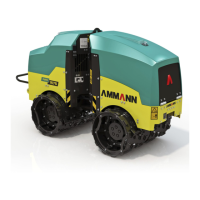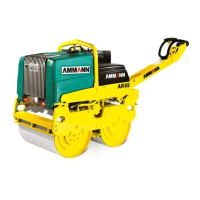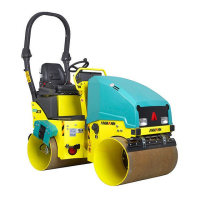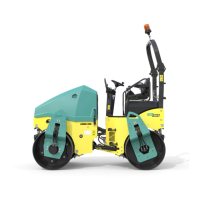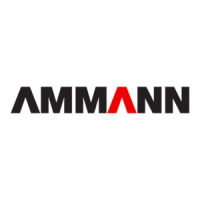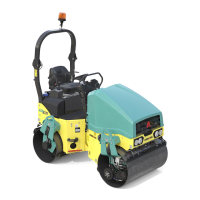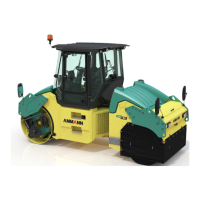Do you have a question about the Ammann ARR 1575 and is the answer not in the manual?
Details the manual's division into chapters for technical data, maintenance, and special tools.
Outlines essential safety rules for all personnel involved in machine repairs.
Provides guidelines for personal protective equipment, workspace, and handling parts during repairs.
Details precautions for working with pressurized hydraulic systems and components.
Covers critical safety procedures for working on the machine's electrical components and battery.
Includes safety notes for welding, sealing procedures, and proper tightening torque application.
Emphasizes health and environmental protection during machine maintenance and waste disposal.
Addresses fire safety measures and procedures for warranty claims and liability.
Introduces the ARR 1575 trench roller, its design, and intended applications.
Identifies components and information found on the machine and engine nameplates.
Provides detailed dimensional drawings and technical specifications of the machine.
Specifies engine oil performance and viscosity classifications, and fuel requirements including biofuel.
Details coolant specifications, mixing, and maintenance, and hydraulic oil requirements.
Lists required lubricants and a table of fluid quantities for various machine parts.
Illustrates and labels the main external components and features of the machine frame.
Covers replacement and lubrication of swinging support, joint head, bearing, and steering piston.
Details gas strut replacement and the process for removing and replacing front and rear bonnets.
Explains how to replace bonnet hinges and sensors, including adjustment procedures.
Covers replacement and adjustment of bonnet stop elements and the swinging support.
Guides on replacing the steering piston and the complex procedure for the swinging joint.
Provides instructions for checking fuel level, replenishment, draining, and cleaning the fuel tank.
Details checking and replenishing hydraulic oil levels, draining, and filter replacement.
Identifies and explains the function of the display unit, indicator lamps, and remote control.
Details error messages displayed on the unit and the logic for safety bar and near/remote halt functions.
Provides instructions for proper operation, positioning, and maintenance of the infrared remote control.
Lists engine compartment fuses and relays, and identifies dashboard components and their functions.
Guides on replacing the remote control battery, display unit, and control unit.
Details hydraulic hose routing and connections for the front drum, left and right sides.
Illustrates and labels valve block components, solenoid valves, and connection points.
Describes the procedure for removing drum extension and the entire drum assembly.
Covers replacement of vibration unit rubber elements and the disassembly of the vibration unit itself.
Guides on installing new bearing rings, spacer rings, and the vibration unit into the housing.
Provides step-by-step instructions for removing and installing the travel hydraulic motor.
Details the process for removing and replacing the vibration hydraulic motor and its components.
Refers to Chapter 7.2 for hydraulic parts related to the rear drum.
Covers the removal and installation procedures for ACEecon components and related parts.
Refers to Chapter 7.4 for mechanical parts related to the rear drum.
Details the removal and preparation steps for replacing the travel pump.
Covers valve block removal, magnetic valve checks, and installation procedures.
Explains how to perform a brake test and replace/adjust the speed magnet.
Outlines the procedure for checking and adjusting engine speed and operating frequency.
Placeholder for vibration system related information, likely detailed in subsequent sections not fully provided.
Refers to Chapter 5.4.9 for the procedure to replace the steering piston.
Provides instructions for cleaning the hydraulic oil cooler fins safely and effectively.
Details how to check and refill the coolant level, including safety precautions.
Identifies key components within the engine compartment, on both left and right sides.
Details the fuses and relays located in the engine compartment and on the chassis rear.
Covers battery charging, removal, installation, and replacement procedures.
Explains how to replace fuel filter elements and water separator filter elements.
Covers checking engine oil level, replenishment, draining, and replacing oil and air filters.
Lists available optional equipment such as safety bars, drum extensions, and scrapers.
Provides detailed steps for removing and installing the safety bar assembly.
Guides on replacing and adjusting sensors, including proper installation distance and alignment.
Details essential safety precautions before performing welding on the machine.
Covers procedures for jump-starting, charging batteries, long-term storage, and replacement.
Identifies potential causes of faults and their symptoms, emphasizing cabling issues.
Provides troubleshooting steps for engine start failures and infrared remote control malfunctions.
Explains near/remote machine halt functions and troubleshooting for control system issues.
Details procedures for checking and adjusting hydraulic pressures for travel, steering, and vibration systems.
Addresses immediate actions and preventive measures in case of machine overturning or oil shock.
Provides a detailed wiring diagram and a legend for all electrical components and connections.
Presents a schematic of the machine's hydraulic system with component numbering.
Lists special tools required for maintenance and provides tables for screw connection tightening torques.
Details the manual's division into chapters for technical data, maintenance, and special tools.
Outlines essential safety rules for all personnel involved in machine repairs.
Provides guidelines for personal protective equipment, workspace, and handling parts during repairs.
Details precautions for working with pressurized hydraulic systems and components.
Covers critical safety procedures for working on the machine's electrical components and battery.
Includes safety notes for welding, sealing procedures, and proper tightening torque application.
Emphasizes health and environmental protection during machine maintenance and waste disposal.
Addresses fire safety measures and procedures for warranty claims and liability.
Introduces the ARR 1575 trench roller, its design, and intended applications.
Identifies components and information found on the machine and engine nameplates.
Provides detailed dimensional drawings and technical specifications of the machine.
Specifies engine oil performance and viscosity classifications, and fuel requirements including biofuel.
Details coolant specifications, mixing, and maintenance, and hydraulic oil requirements.
Lists required lubricants and a table of fluid quantities for various machine parts.
Illustrates and labels the main external components and features of the machine frame.
Covers replacement and lubrication of swinging support, joint head, bearing, and steering piston.
Details gas strut replacement and the process for removing and replacing front and rear bonnets.
Explains how to replace bonnet hinges and sensors, including adjustment procedures.
Covers replacement and adjustment of bonnet stop elements and the swinging support.
Guides on replacing the steering piston and the complex procedure for the swinging joint.
Provides instructions for checking fuel level, replenishment, draining, and cleaning the fuel tank.
Details checking and replenishing hydraulic oil levels, draining, and filter replacement.
Identifies and explains the function of the display unit, indicator lamps, and remote control.
Details error messages displayed on the unit and the logic for safety bar and near/remote halt functions.
Provides instructions for proper operation, positioning, and maintenance of the infrared remote control.
Lists engine compartment fuses and relays, and identifies dashboard components and their functions.
Guides on replacing the remote control battery, display unit, and control unit.
Details hydraulic hose routing and connections for the front drum, left and right sides.
Illustrates and labels valve block components, solenoid valves, and connection points.
Describes the procedure for removing drum extension and the entire drum assembly.
Covers replacement of vibration unit rubber elements and the disassembly of the vibration unit itself.
Guides on installing new bearing rings, spacer rings, and the vibration unit into the housing.
Provides step-by-step instructions for removing and installing the travel hydraulic motor.
Details the process for removing and replacing the vibration hydraulic motor and its components.
Refers to Chapter 7.2 for hydraulic parts related to the rear drum.
Covers the removal and installation procedures for ACEecon components and related parts.
Refers to Chapter 7.4 for mechanical parts related to the rear drum.
Details the removal and preparation steps for replacing the travel pump.
Covers valve block removal, magnetic valve checks, and installation procedures.
Explains how to perform a brake test and replace/adjust the speed magnet.
Outlines the procedure for checking and adjusting engine speed and operating frequency.
Placeholder for vibration system related information, likely detailed in subsequent sections not fully provided.
Refers to Chapter 5.4.9 for the procedure to replace the steering piston.
Provides instructions for cleaning the hydraulic oil cooler fins safely and effectively.
Details how to check and refill the coolant level, including safety precautions.
Identifies key components within the engine compartment, on both left and right sides.
Details the fuses and relays located in the engine compartment and on the chassis rear.
Covers battery charging, removal, installation, and replacement procedures.
Explains how to replace fuel filter elements and water separator filter elements.
Covers checking engine oil level, replenishment, draining, and replacing oil and air filters.
Lists available optional equipment such as safety bars, drum extensions, and scrapers.
Provides detailed steps for removing and installing the safety bar assembly.
Guides on replacing and adjusting sensors, including proper installation distance and alignment.
Details essential safety precautions before performing welding on the machine.
Covers procedures for jump-starting, charging batteries, long-term storage, and replacement.
Identifies potential causes of faults and their symptoms, emphasizing cabling issues.
Provides troubleshooting steps for engine start failures and infrared remote control malfunctions.
Explains near/remote machine halt functions and troubleshooting for control system issues.
Details procedures for checking and adjusting hydraulic pressures for travel, steering, and vibration systems.
Addresses immediate actions and preventive measures in case of machine overturning or oil shock.
Provides a detailed wiring diagram and a legend for all electrical components and connections.
Presents a schematic of the machine's hydraulic system with component numbering.
Lists special tools required for maintenance and provides tables for screw connection tightening torques.
| Brand | Ammann |
|---|---|
| Model | ARR 1575 |
| Category | Construction Equipment |
| Language | English |
